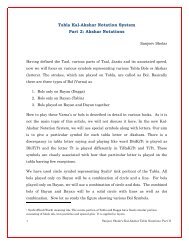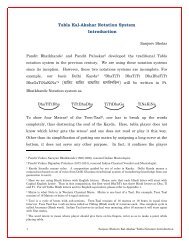Tabla Kal-Akshar Notation System Part 1: Kal, Taal ... - Tabla Notations
Tabla Kal-Akshar Notation System Part 1: Kal, Taal ... - Tabla Notations
Tabla Kal-Akshar Notation System Part 1: Kal, Taal ... - Tabla Notations
You also want an ePaper? Increase the reach of your titles
YUMPU automatically turns print PDFs into web optimized ePapers that Google loves.
9 laghus in a matra will be considered as Tisra Jaati with triple speed. For<br />
example, DhaTraKa DhiKiTt KaTaGaDiGaNaa composition, which starts with<br />
Tisra Jaati at normal speed and then if in this composition if the word consists of<br />
DhiKiTtKaTaGaDiGaNaa then it will be consider as a Tisra Jaati in triple speed.<br />
However, if the composition begins with 9 laghus or the words are such that it<br />
cannot be broken in-group of three, then it will be considered as Sankirna Jaati.<br />
For example, DhaTiDhaGeNaTiNaKiNaa, here the composition will begin playing<br />
all 9 laghus in one matra, and then it is a Sankirna Jaati. At present, there is no<br />
Jaati for 11 or 13 laghus. In order to have a complete notation system, we must<br />
have Jaati for 11 or 13 laghus composition as theoretically it is possible to have<br />
these kind of compostion but statistically it's use will be rare. We will now<br />
introduce two NEW Jaati’s for these laghus as<br />
Ekadash (Eka – One, Dash – Ten, a Sanskrit word for 11) for 11 laghus.<br />
Trayodash (Tri – 3, Dash – Ten, a Sanskrit word for 13) for 13 laghus.<br />
As explained earlier, theoretically, it is possible to have more than 16 laghus in<br />
one Matra, but these compositions are very very rare and we will not consider it<br />
in our discussion.<br />
Having considered the number of laghus in a given Matra lets study it is Laya or<br />
speed. Since the Laya by definition is the fixed time interval between two<br />
matras, we cannot vary time between two matras even if different matras have<br />
different laghus within the same Jaati. For example, in a given Tisra Jaati<br />
composition, one matra can have three laghus (1/3 rd value each) while another<br />
matra can have six laghus (1/6 th value each). However, time scale being same or<br />
the speed of the beat is same, one has to play both matras in the same time. Thus<br />
first matra having three laghus needs to be played at normal speed (having 1/3 rd<br />
value), but the next matra should be played at double speed, because in the same<br />
time period one has to play six bols or strokes instead of three. Thus, the laya or<br />
speed is double. For example,<br />
5 Sanjeev Shelar's <strong>Kal</strong>-<strong>Akshar</strong> <strong>Tabla</strong> <strong>Notation</strong>: <strong>Part</strong> I




 Ym{VQ> YmYm{VQ - Tabla Notations"
>
Ym{VQ> YmYm{VQ - Tabla Notations"
>